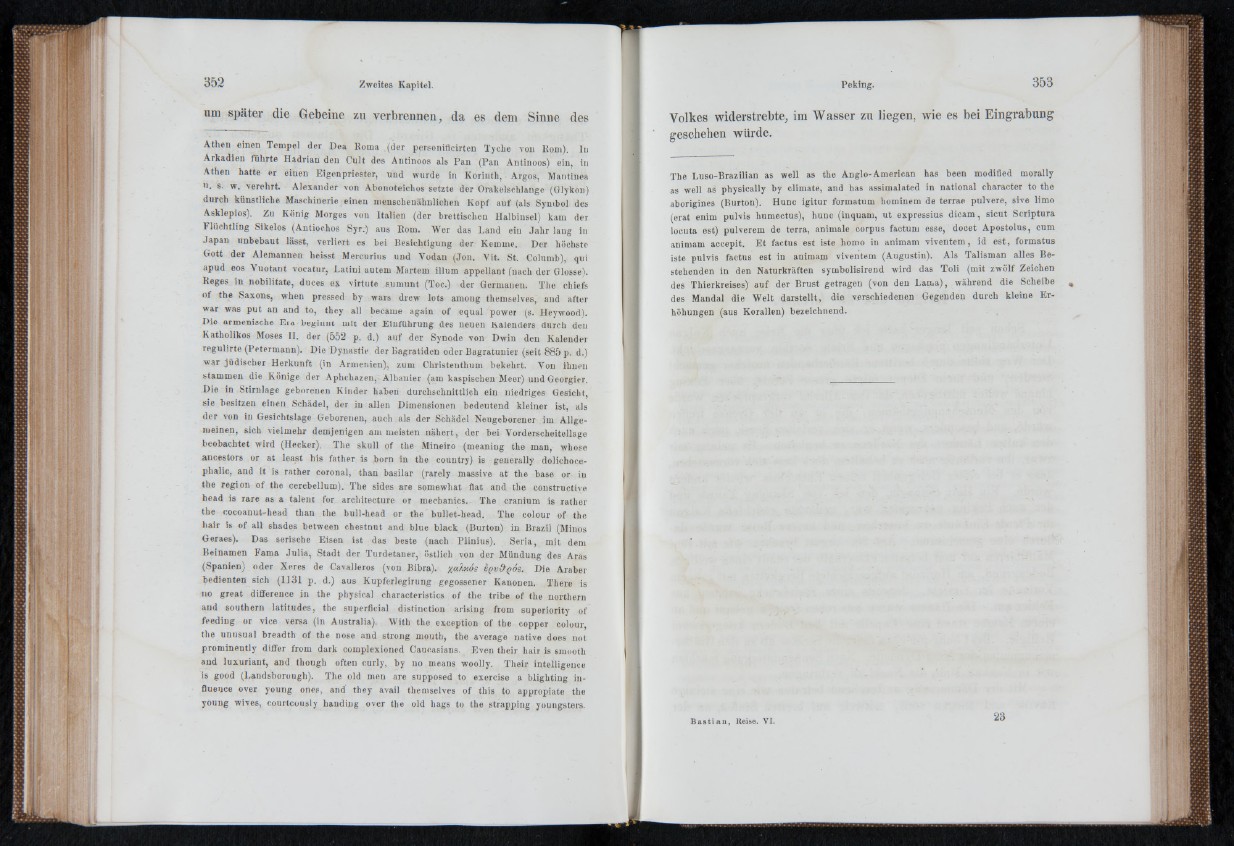
um später die Gebeine zu verbrennen, da es dem Sinne des
Athen einen Tempel der Dea Roma (der personiflcirten Tyche von Rom), in
Arkadien führte Hadrian den Cult des Antinoos als Pan (Pan Antinoos) ein, in
Athen hatte er einen Eigenpriester, und wurde in Korinth, Argos, Mantinea
u. s. w. verehrt. Alexander von Ahonoteichos setzte der Orakelschlauge (Glykon)
durch künstliche Maschinerie einen menschenähnlichen Kopf auf (als Symbol des
Asklepios). Zu König Morges von Italien (der brettischen Halbinsel) kam der
Flüchtling Sikelos (Antiochos Syr.) aus Rom. Wer das Land ein Jahr lang in
Japan unbebaut lässt, verliert es bei Besichtigung der Kemme. Der höchste
Gott der Alemannen heisst Mercurius und Vodan (Jon. Vit. St. Columb), qui
apud eos Vuotant vocatur, Latini autem Martern ilium appellant (nach der Glosse).
Reges in nobilitate, duces ex virtute sumunt (Toe.) der Germanen. The chiefs
of the Saxons, when pressed by wars drew lots among themselves, and after
war was pu t an and to, they all became again of equal power (s. Heywood).
Die armenische Era beginnt mit der Einführung des neuen Kalenders durch den
Katholikos Moses II. der (552 p. d.) auf der Synode von Dwin den Kalender
regulirte (Petermann). Die Dynastie der Bagratiden oder Bagratunier (seit 885 p. d.)
war jüdischer Herkunft (in Armenien), zum Christenthum bekehrt. Von ihnen
stammen die Könige der Aphchazen, Albanier (am kaspischen Meer) und Georgier.
Die in Stirnlage geborenen Kinder haben durchschnittlich ein niedriges Gesicht,
sie besitzen einen Schädel, der in allen Dimensionen bedeutend kleiner ist, als
der von in Gesichtslage Geborenen, auch.als der Schädel Neugeborener im. Allgemeinen,
sich vielmehr demjenigen am meisten nähert, der bei Vorderscheitellage
beobachtet wird (Hecker). The skull of the Mineiro (meaning the man, whose
ancestors or at least his father is born in the country) is generally dolichocephalic,
and it is rather coronal, than basilar (Tarely massive at the base or in
the region of the cerebellum).'The sides are somewhat flat and the constructive
head is rare as a talent for. architecture or mechanics.- The cranium is rather
the cocoanut-head than the bull-head or the bullet-head. The colour of the
hair is of all shades between chestnut and blue black (Burton) in Brazil (Minos
Geraes). Das serisehe Eisen ist das beste (nach Plinius). Seria, mit dem
Beinamen Fama Julia, Stadt der Turdetaner, östlich von der Mündung des Aras
(Spanien) oder Xeres de Cavalleros (von Bibra), '/alxos iy v d ’qos. Die Araber
bedienten sich (1131 p. d.) aus Kupferlegirung gegossener Kanonen. There is
no great difference .in the physical characteristics of the tribe of the northern
and southern latitudes, the superficial distinction arising from superiority of
feeding or vice versa (in Australia). With the exception of the copper colour,
the unusual breadth of the nose and strong mouth, the average native does not
prominently differ from dark complexioned Caucasians. Even their hair is smooth
and luxuriant, and though often cnrly, by no means woolly. Their intelligence
is good (Landsborough). The old men are supposed to exercise a blighting influence
over young ones, and they avail themselves of this to appropiate the
young wives, courteously handing over the old hags to the strapping youngsters.
Volkes widerstrebte, im Wasser zu liegen, wie es bei Eingrabung
geschehen würde.
The Luso-Brazilian as well as the Anglo-American has been modified morally
as well as physically by climate, and has assimalated in national character to the
aborigines (Burton). Hunc igitur formatum hominem de terrae pulvere, sive limo
(erat enim pulvis humectus), hunc (inquam, ut expressius dicam, sicut Scriptura
locuta est) pulverem de terra, animale corpus factum esse, docet Apostolus, cum
animam accepit. E t factus est iste homo in animam viventem, id est, formatus
iste pulvis factus est in animam viventem (Augustin). Als Talisman alles Bestehenden
in den Naturkräften symbolisirend wird das Toli (mit zwölf Zeichen
des Thierkreises) auf der Brust getragen (von den Lama), während die Scheibe ,
des Mandal die Welt darstellt, die verschiedenen Gegenden durch kleine E rhöhungen
(aus Korallen) bezeichnend.
B a s tia n , R e i s e , VI.